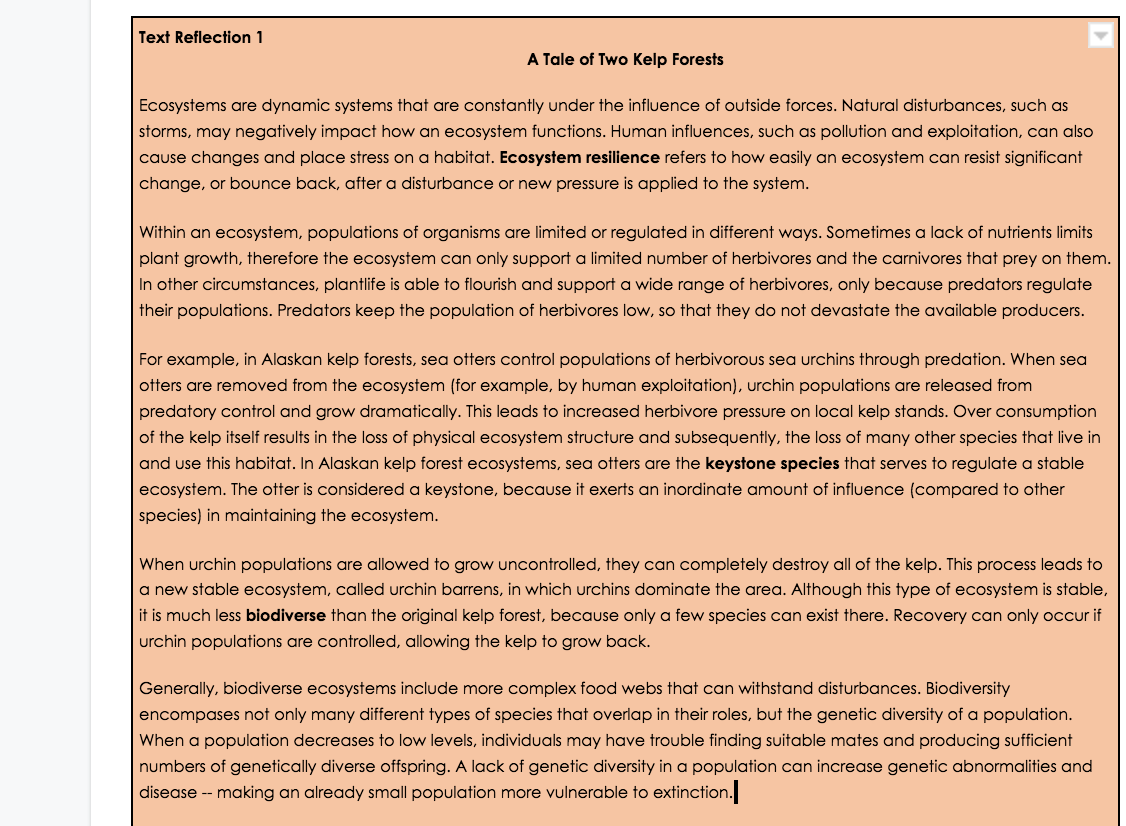Explain the immediate and secondary effects of removing otters from a kelp forest ecosystem. (use the word: keystone species, biodiverse/biodiversity)
Explain the immediate and secondary effects of removing otters from a kelp forest ecosystem. (use the word: keystone species, biodiverse/biodiversity)
Biology: The Dynamic Science (MindTap Course List)
4th Edition
ISBN:9781305389892
Author:Peter J. Russell, Paul E. Hertz, Beverly McMillan
Publisher:Peter J. Russell, Paul E. Hertz, Beverly McMillan
Chapter54: Ecosystems And Global Change
Section: Chapter Questions
Problem 10TYK: Which of the following statements is supported by the results of studies at the Hubbard Brook...
Related questions
Question
2) Explain the immediate and secondary effects of removing otters from a kelp forest ecosystem. (use the word: keystone species, biodiverse/biodiversity)

Transcribed Image Text:Text Reflection 1
A Tale of Two Kelp Forests
Ecosystems are dynamic systems that are constantly under the influence of outside forces. Natural disturbances, such as
storms, may negatively impact how an ecosystem functions. Human influences, such as pollution and exploitation, can also
cause changes and place stress on a habitat. Ecosystem resilience refers to how easily an ecosystem can resist significant
change, or bounce back, after a disturbance or new pressure is applied to the system.
Within an ecosystem, populations of organisms are limited or regulated in different ways. Sometimes a lack of nutrients limits
plant growth, therefore the ecosystem can only support a limited number of herbivores and the carnivores that prey on them.
In other circumstances, plantlife is able to flourish and support a wide range of herbivores, only because predators regulate
their populations. Predators keep the population of herbivores low, so that they do not devastate the available producers.
For example, in Alaskan kelp forests, sea otters control populations of herbivorous sea urchins through predation. When sea
otters are removed from the ecosystem (for example, by human exploitation), urchin populations are released from
predatory control and grow dramatically. This leads to increased herbivore pressure on local kelp stands. Over consumption
of the kelp itself results in the loss of physical ecosystem structure and subsequently, the loss of many other species that live in
and use this habitat. In Alaskan kelp forest ecosystems, sea otters are the keystone species that serves to regulate a stable
ecosystem. The otter is considered a keystone, because it exerts an inordinate amount of influence (compared to other
species) in maintaining the ecosystem.
When urchin populations are allowed to grow uncontrolled, they can completely destroy all of the kelp. This process leads to
a new stable ecosystem, called urchin barrens, in which urchins dominate the area. Although this type of ecosystem is stable,
it is much less biodiverse than the original kelp forest, because only a few species can exist there. Recovery can only occur if
urchin populations are controlled, allowing the kelp to grow back.
Generally, biodiverse ecosystems include more complex food webs that can withstand disturbances. Biodiversity
encompases not only many different types of species that overlap in their roles, but the genetic diversity of a population.
When a population decreases to low levels, individuals may have trouble finding suitable mates and producing sufficient
numbers of genetically diverse offspring. A lack of genetic diversity in a population can increase genetic abnormalities and
disease -- making an already small population more vulnerable to extinction.
Expert Solution
This question has been solved!
Explore an expertly crafted, step-by-step solution for a thorough understanding of key concepts.
This is a popular solution!
Trending now
This is a popular solution!
Step by step
Solved in 2 steps

Knowledge Booster
Learn more about
Need a deep-dive on the concept behind this application? Look no further. Learn more about this topic, biology and related others by exploring similar questions and additional content below.Recommended textbooks for you

Biology: The Dynamic Science (MindTap Course List)
Biology
ISBN:
9781305389892
Author:
Peter J. Russell, Paul E. Hertz, Beverly McMillan
Publisher:
Cengage Learning

Biology: The Unity and Diversity of Life (MindTap…
Biology
ISBN:
9781305073951
Author:
Cecie Starr, Ralph Taggart, Christine Evers, Lisa Starr
Publisher:
Cengage Learning

Biology: The Unity and Diversity of Life (MindTap…
Biology
ISBN:
9781337408332
Author:
Cecie Starr, Ralph Taggart, Christine Evers, Lisa Starr
Publisher:
Cengage Learning

Biology: The Dynamic Science (MindTap Course List)
Biology
ISBN:
9781305389892
Author:
Peter J. Russell, Paul E. Hertz, Beverly McMillan
Publisher:
Cengage Learning

Biology: The Unity and Diversity of Life (MindTap…
Biology
ISBN:
9781305073951
Author:
Cecie Starr, Ralph Taggart, Christine Evers, Lisa Starr
Publisher:
Cengage Learning

Biology: The Unity and Diversity of Life (MindTap…
Biology
ISBN:
9781337408332
Author:
Cecie Starr, Ralph Taggart, Christine Evers, Lisa Starr
Publisher:
Cengage Learning

Biology (MindTap Course List)
Biology
ISBN:
9781337392938
Author:
Eldra Solomon, Charles Martin, Diana W. Martin, Linda R. Berg
Publisher:
Cengage Learning

Biology 2e
Biology
ISBN:
9781947172517
Author:
Matthew Douglas, Jung Choi, Mary Ann Clark
Publisher:
OpenStax

Biology Today and Tomorrow without Physiology (Mi…
Biology
ISBN:
9781305117396
Author:
Cecie Starr, Christine Evers, Lisa Starr
Publisher:
Cengage Learning